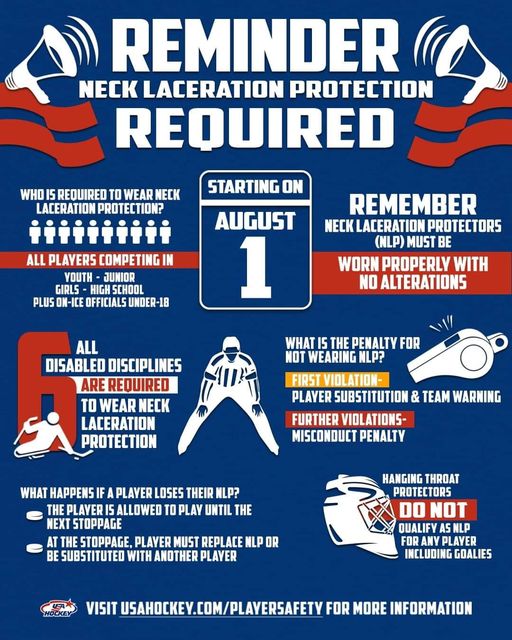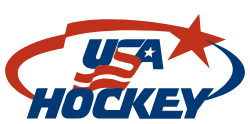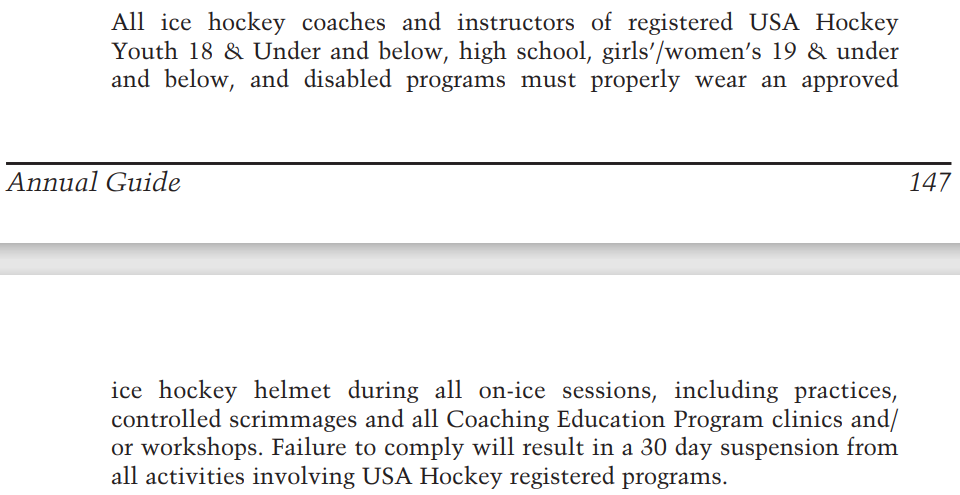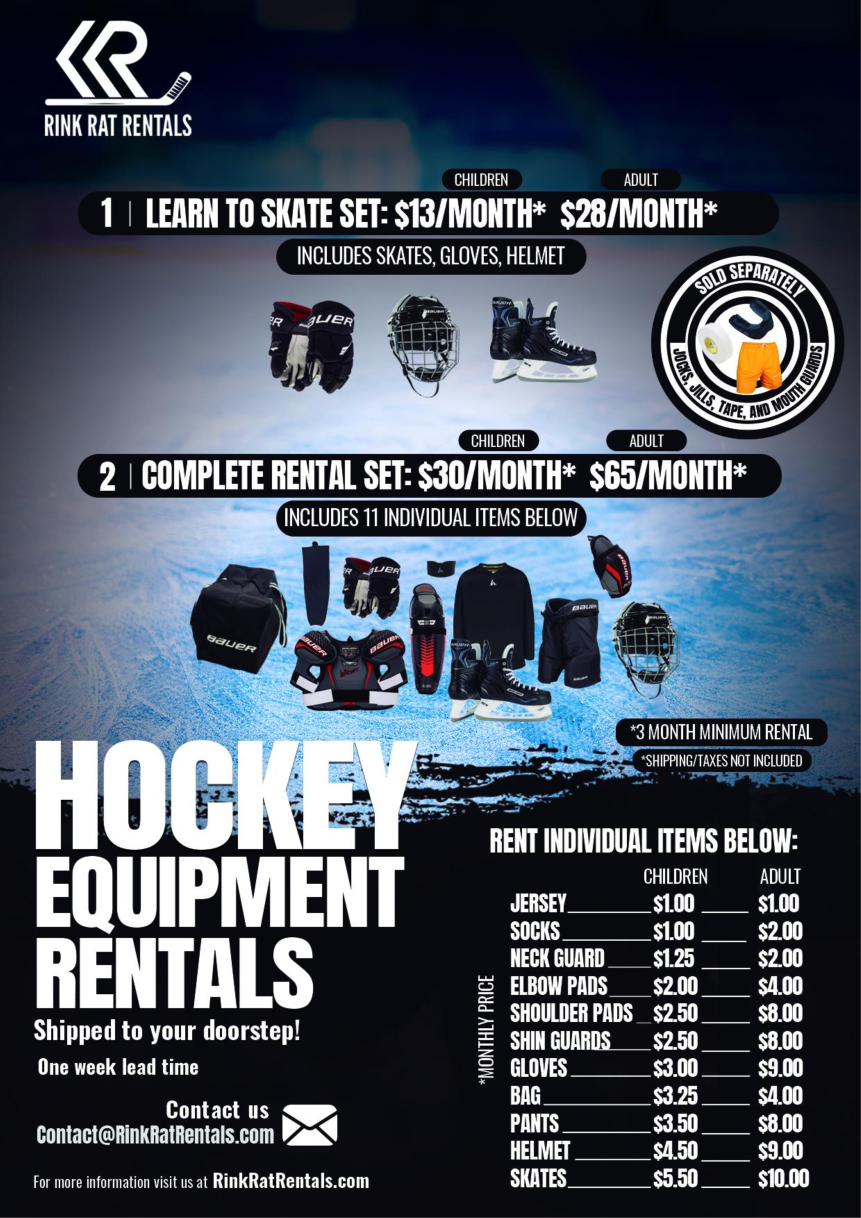
NECK GUARDS & HELMETS ARE MANDATORY FOR ALL PLAYERS
While KVHA has always required neck guards to keep our players safe, USA Hockey is now requiring them as of August 2024. https://www.usahockey.com/news_article/show/1298379
Every player and goalie, in every age classification/division, is required to wear a neck guard (or a throat/neck shield for goalies) during all practices, all training sessions, and all games, whether using home facilities, or travelling to any other arena/rink. The neck guard must be commercially manufactured and unaltered. The neck guard may be either separate or part of an undergarment with a neck guard extension.
MOUTHGUARDS ARE REQUIRED FOR 12U & OLDER PLAYERS
All players, including goalkeepers, in the 12 & under through 19 & under age classifications are required to wear a colored (non-clear) internal mouthpiece that covers all the teeth of one jaw, customarily the upper. It is strongly recommended, in all classifications, that all players wear a mouthpiece form fitted by a dentist.
During games, the on-ice officials can require the player to leave the ice until proper equipment is worn. For the first violation of this rule, the team shall be issued a warning. A misconduct penalty for an equipment violation shall be assessed to any player or goalkeeper of that team for a subsequent violation during a game.

USA Hockey Rules regarding equipment can be found at the following link: https://www.usahockeyrulebook.com/page/show/1084402-rule-304-protective-equipment
Rule 304 | Protective Equipment
(Note) Not all is mandatory in all age classifications. However, if not mandated by rule, USA Hockey strongly recommends that all skaters and s in all age classifications properly wear an internal mouthpiece, a approved helmet and a approved full facemask for all games and practices.
(a) Each is personally responsible to wear for all games, warm-ups and practices. Such equipment should include gloves, shin pads, shoulder pads, elbow pads, hip pads or padded hockey pants, protective cup, tendon pads plus all head as required by USA Hockey rules. It is recommended that all be designed specifically for ice hockey.
(b) All , except gloves, padded hockey pants, helmet/facemask and ’s leg guards, must be worn under the uniform.
(Note) s, including s, violating this rule shall not be permitted to participate in the game until such equipment has been corrected or removed.
(c) All s, including s, in all age classifications except Adults, are required to properly wear a approved helmet as designed by the manufacturer and with no alterations and chin strap properly fastened.
(Note) certification includes an expiration date on the sticker and a helmet that has an expiration date that has expired is no longer considered certified. The may not wear a helmet that does not have a valid and current certification sticker.
s in the Adult classification must wear a hockey helmet (including non- approved) with chin strap properly fastened.
All s on the s’ and the bench must wear the protective helmet/facemask while in the bench area. For a violation of this rule, after a warning by the Referee, a misconduct for an equipment violation shall be assessed to the offending .
(d) All s, including s, in all age classifications below Adults, are required to wear a facemask certified by , plus any chin protection that accompanies the facemask.
(Note) Any helmet or facemask that is altered except as permitted in Rule 304(c) shall be deemed to be illegal equipment and shall not be allowed to be used in a game. The , or such equipment, shall be removed from the game until corrected. (This shall include helmets from which a part has been cut or removed, facemasks from which the chin-cup has been removed or any other such alterations from the original manufacturing specifications.)
(e) In all classifications, including Adults, if a skater’s helmet/facemask comes off during play, the officials shall stop play immediately. The skater shall be ruled off the ice and may not participate in the game until completion of the ensuing .
In all classifications, if the ’s helmet/facemask comes off during play, the officials shall stop play immediately. However, the shall not be ruled off the ice prior to the .
A minor for delay of game shall be assessed to a or skater who causes a stoppage of play by deliberately removing their helmet/facemask during play.
(f) All s, including s, in the 12 & under (Youth and Girls’) through Youth 18 & under (including High School) and Girls’ 19 & under age classifications are required to wear a colored (non-clear) internal mouthpiece that covers all the remaining teeth of one jaw, customarily the upper. It is strongly recommended, in all classifications, that all s wear a mouthpiece form fitted by a dentist.
For the first violation of this rule, the team shall be issued a warning. A misconduct for an equipment violation shall be assessed to any or of that team for a subsequent violation during that game.
(g) USA Hockey recommends that s wear a neck laceration protector, choosing a design that covers as much of the neck area as possible.
(h) All s who wear the required, or recommended, must wear it in the manner for which it is designed.
For violation of this rule, following a team warning, a misconduct for an equipment violation shall be imposed.
HELMETS ARE MANDATORY FOR COACHES AND TRAINERS
The rule requiring coaches and trainers to wear a helmet is not in the protective equipment clause of the USA Hockey rules, it is located in the USA Hockey annual guide, page 147; https://www.usahockey.com/rules
All ice hockey coaches and instructors of registered USA Hockey Youth 18 & under and below, high school, girls 19 & under and below, and disabled programs must properly wear an approved ice hockey helmet during all on-ice sessions, including practices, controlled scrimmages and all Coaching Education Program clinics and/or workshops. Failure to comply will result in a 30-day suspension from all activities involving USA Hockey registered programs.
It is the head coach’s responsibility to make sure this rule is followed for all trainers that they have out to skate on their ice. Allowing a trainer on your ice without a helmet leaves the head coach and the association open to liability if that trainer is injured during your USA Hockey practice.

 The Kensington Valley Hockey Association is proud to partner with Rink Rat Rentals! Rink Rat Rentals offers high-quality rental equipment for youth hockey players of all ages, providing an affordable alternative to buying new gear. This partnership ensures that families have access to all the gear they need, whether your child is a first-year skater or already a few seasons in.
The Kensington Valley Hockey Association is proud to partner with Rink Rat Rentals! Rink Rat Rentals offers high-quality rental equipment for youth hockey players of all ages, providing an affordable alternative to buying new gear. This partnership ensures that families have access to all the gear they need, whether your child is a first-year skater or already a few seasons in.
The process is simple: just visit www.rinkratrentals.com, select the gear you need, choose your rental period, and have it delivered right to your door. There is typically a 1-week lead time on all orders so plan accordingly for the upcoming hockey season. If you have any questions or need assistance, feel free to reach out via email at contact@rinkratrentals.com.

